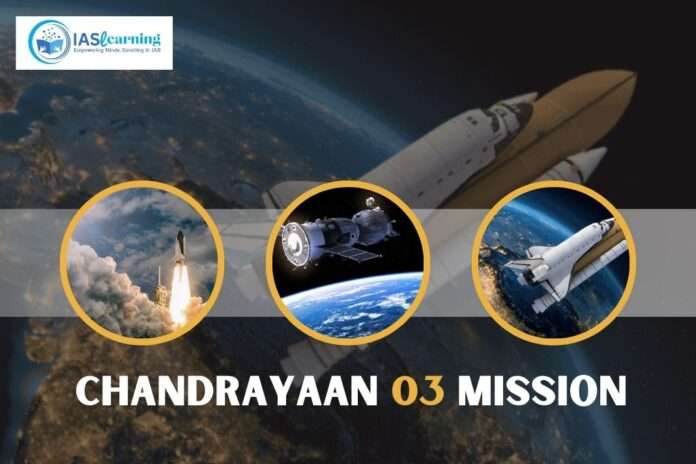About Chandrayaan 3
- The LMV3 launch vehicle carrying Chandrayaan 3 was launched in July 2023 from the Satish Dhawan Space Center in Sriharikota, India. It is a follow-up mission to Chandrayaan-2, which was launched in 2019 and had as its goal to place a rover on the lunar South Pole.
- After the Vikram lander of Chandrayaan-2 failed, another mission was suggested in conjunction with Japan for 2024 to showcase the landing capabilities of the Lunar Polar Exploration Mission.
Goals and Objectives of the Chandrayaan 3 Mission
- to show off a secure and gentle lunar landing
- to show off lunar wandering for rovers
- to carry out in-situ scientific research.

Design and Chandrayaan 3’s component parts
- The Chandrayaan 3 spacecraft has a total mass of 3900 kg, of which the propulsion module weighs 2148 kg and the lander module weighs 1752 kg, including the Rover’s 26 kg mass.
- The propulsion module has a power generation capacity of 758 W, while the lander module has a capacity of 738 W.
- The essential EMI-EMC test was successfully accomplished by Chandrayaan 3’s Lander.
- The Chandrayaan-3 lander is powered by four throttle-capable engines. A Laser Doppler Velocimeter (LDV) will be included.
- A landing module and an orbiter will be on Chandrayaan 3. But unlike Chandrayaan-2, this orbiter won’t be equipped with a research payload.
- Its only tasks will be to launch the lander to the moon, monitor the landing from orbit, and maintain communication with the earth station.
- Propulsion, Lander, and Rover are the three main parts that make up Chandrayaan 3.
Major Chandrayaan 3 Modules
Propulsion Unit
- The propulsion module will be separated from the lander module after it has carried the lander and rover combination to the final 100 km circular polar orbit of the moon. It serves as a satellite relay for communications. It contains:
- Studying the spectral and polarimetric measurements of Earth from lunar orbit is the goal of the Spectro-Polarimetry of Habitable Planet Earth (SHAPE) mission.
Launch Payload
It is capable of gentle landing and rover deployment. It contains:
- Radio Anatomy of Moon Bound Hypersensitive Ionosphere and Atmosphere, or RAMBHA-LP Langmuir To measure the plasma density and its temporal fluctuations.
- Chandra’s Surface Thermophysical Experiment (ChaSTE) will gauge the lunar surface’s thermal conductivity and temperature characteristics close to the poles
- monitoring the seismicity at the landing site and defining the composition of the lunar crust and mantle with the Instrument for Lunar Seismic Activity (ILSA)
- Studies involving lunar laser ranging can be handled by the NASA Laser Retroreflector Array (LRA).

Vehicle Payload of Chandrayaan 3
- The lunar surface will be chemically analyzed in-situ by the rover. Seismometers, heat flow experiments, and spectrometers will all be on board the rover. It contains:
- To further improve understanding of the lunar surface, scientists are using the Alpha Particle X-Ray Spectrometer (APXS) to determine the chemical composition and infer mineralogical composition.
- To ascertain the elemental composition (Mg, Al, Si, K, Ca, Ti, Fe) of lunar soil and rocks at the lunar landing site, scientists used the Laser Induced Breakdown Spectroscope (LIBS).
- Similar to the Vikram rover on Chandrayaan-2, the lander/rover will have enhancements to aid ensure a secure landing.
Chandrayaan-3 Activities’ Main Focus
- In this exploration, the surface, subsurface, and exosphere are all being studied. At a distance of 100 km from the lunar orbit, it will take pictures of the surface in order to analyze it.
- This spacecraft’s rover will communicate with the planet using an orbiter from Chandrayaan-2.
- Chandrayaan-3 will investigate the Moon’s surface, particularly the South Pole, which hasn’t seen sunlight in a few billion years. Scientists and astronomers are optimistic that ice and rich mineral deposits exist in these shadowy regions of the lunar surface.
- The lunar South Pole is a difficult place to go through because of its severe temperatures and parts that are always in the shade and never receive sunlight.
- It is believed that the south pole region is home to substantial concentrations of water molecules, which are likely frozen in the craters’ constant shadows.
- Cold traps and early Solar System fossil records can be found in craters near the South Pole.
Mission Chandrayaan-2
- An orbiter, a lander, and a rover made up Chandrayaan-2, and they were all outfitted with tools for studying the moon.
- While the Lander and Rover modules were to be separated to make a soft landing on the moon’s surface, the Orbiter would observe the moon from a 100-km orbit.
- The Lander module was given the name Vikram in honor of Vikram Sarabhai, and the Rover module was given the name Pragyaan, which means knowledge.
- It was launched on the GSLV-Mk III, the nation’s most potent geosynchronous launch vehicle.
- However, lander Vikram crashed-landed rather than making a controlled landing, which prevented rover Pragyaan from successfully exploring the moon’s surface.
Important Data Collected by Chandrayaan-2
- Through remote sensing, water molecules and trace amounts of sodium, chromium, and manganese were found on the moon for the first time.
- The discovery of numerous microflares outside the active zone is significant for understanding the mechanism underlying the heating of the solar corona.
Chandrayaan-3’s significance for India
- Next interplanetary missions will benefit from Chandrayaan-3, which highlights the nation’s scientific and technological prowess. Future interplanetary expeditions by ISRO can benefit from a vital technology known as the ability to softly land on planetary bodies.
- LVM3’s potential for Gaganyaan: Because LVM3 will be used for that mission, Chandrayaan-3’s successful launch has gained significance because it has further improved the launch vehicle’s dependability.
- Knowledge and experience gained: India has benefited greatly from the Chandrayaan-3 mission’s knowledge and expertise in space exploration, which can be used in other areas including satellite technology and space tourism.
- More capability development: Chandrayaan-3 will advance space research and create new capabilities.
- New possibilities for space exploration and resource use have been made possible by Chandrayaan-1’s discovery of water on the Moon, including the possibility of future lunar settlements and space mining.
- Younger generation inspiration: The Chandrayaan mission has motivated young people to seek jobs in STEM (science, technology, engineering, and mathematics) disciplines, which will help the nation progress as a whole.
- Increasing private investment in space technologies: Chandrayaan-3’s performance may increase investor confidence and draw more money into the space business.
Way ahead
- It is an important accomplishment for India that Chandrayaan Mission, in the shape of Chandrayaan 1 and 2, has shown the nation’s capacity for space exploration and created new opportunities for future study and development.
- By maximizing payload configurations, utilizing available spacecraft resources, and enhancing lander capabilities by including crucial additions like “lander hazard detection and avoidance cameras,” the Chandrayaan-3 mission needs to address previous challenges and be more robust than predecessor mission.
- Read morehttps://www.businesstoday.in/
- For more Detailshttps://iaslearning.in/




